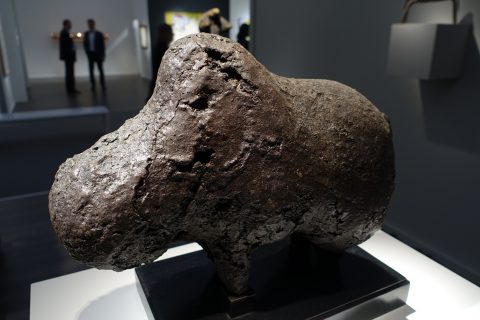Frieze Masters 2015: a large scale process of understanding is taking place
- Gotthard Graubner, at Axel Vervoordt.
- Michelangelo Pistoletto, at Galleria Continua.
- Christo, at Annely Juda.
- Egyptian painting wood box, 1186-945 BC, at Rupert Wace.
- Karagwe Quadrupped figure, Tanzania, at Didier Claes.
- Boli Bamana figure, Mali, at Didier Claes.
- Santi Buglioni and Fausto Melotti, at Moretti + Hauser&Wirth.
While we are writing this article a meeting of Frieze Masters’ board is taking place in loco to discuss about the opening days: is the edition number third doing well? According to the impressive number of people still cueing at the doors of the suspended white temporary pavilion less than half of an hour before the closing of the fair’s vip opening the answer is anyway positive; and as an Italian art dealer who has been taking part to Frieze Masters since the first edition said to Cfa that same evening “if they open the door also to antiques furnitures the Tefaf will have a very serious competitor here in London”.
All the top quality works of art at his booth are still available, and at day two he is not the only one who hasn’t sold any piece yet. But other galleries, such as Helly Nahmad for instance – who is presenting a spectacular installation dedicated to Jean Dubuffet similar to the one he presented last year -, or also Axel Vervoordt – who has already sold the intense early Gotthard Graubner at his stand – are doing quite well. Moreover, many collectors are arriving today in London from all over Europe, so the general consensus is that buyers are responding more and more positively to this new masters’ call.
In comparison to the last edition, we have noticed even more ambitious booths and that is also becoming a main difference between the Frieze’s two still distinct identities. While the large part of contemporary art galleries are not presenting thematic projects at their stand, at Frieze Masters dealers have taken the occasion to set up some museum standard (and museums oriented) exhibitions. Among them, for instance, there is the solo dedicated by Galleria Continua to Michelangelo Pistoletto’s very early works gathering together 8 seminal pieces, all still belonging to the artist personal collection. He asked to the gallery to sell the entire group to a museum, but only under his approval. The total price is 11 million, that is fair considering that the artist’s “Figura su sfondo nero” sold last night at Sotheby’s quite successful Italian Sale for £725,000, almost doubled the estimate.
The remarkable works by Christo at Annely Juda are a second good example of this approach: “Wrapped table and wrapped chair” from 1963, a touching “Packed supermarket cart”, also from 1963, and a fat “Package” from 1962. These are the highlights from a selection of pieces covering the crucial period in the artist’s career that goes from 1958 to 1972, when he wrapped the Reichstag in West Berlin. Also in this case art institutions are welcomed to step in.
Some seminal pieces of tribal art, and from the ancient Egypt (as the delicate painted wooden box at Rupert Wace) are proving that Frieze Masters is becoming the perfect stage also for kind of artworks generally reserved to fine art fairs such as the Tefaf or the Biennale des Antiquaires in Paris. In this regard we recommend two pieces presented by Didier Claes to the public for the very first time. The first one is a “Boli Bamana” figure from Mali, a ritual tool covered by a thick encrusted surface probably hiding the shape of an antelope. A contemporary artists such as Camille Henrot would love the humanity this remarkable object mirrors, and she would love also the quite expensive Karagwe Quadrupped tapered figure from Tanzania (probably a bull) that we also suggest at Claes, and that is the only one still in private hands among the only four of this kind currently known. In this case the request is a bit less than half of a million pound.
Notwithstanding these pieces, or the Gunther Uecker’s on exhibition at Nicolò Cardi and Dominique Levy, what is marking Frieze Masters 2015 has been the collaboration between Moretti Gallery and Hauser&Wirth, the first of this kind we remember taking place in a main art fair, and the first one operating a visual associations that would have been possible only in a museum exhibition, or private collection. At this point we are tempted to describe these temporary proximities as a fascinating dialogue between Picabia, Calder and Moore with pieces from Bartolomeo Bellotto, Andrea della Robbia and Santi Buglioni, just to name a few of the illustrious artists on the list. But we are not going to. We already wrote it, objects don’t speak at all. People do speak, with themselves or with other people, and that is the main point here. Sharing the same space is generally considered an opportunity to meet the others and make knowledge circulating. Thus, it is a large scale information-based process of understanding what we are facing these days, not just some ephemeral visual stimulus: the show has just began.
October 17, 2015







